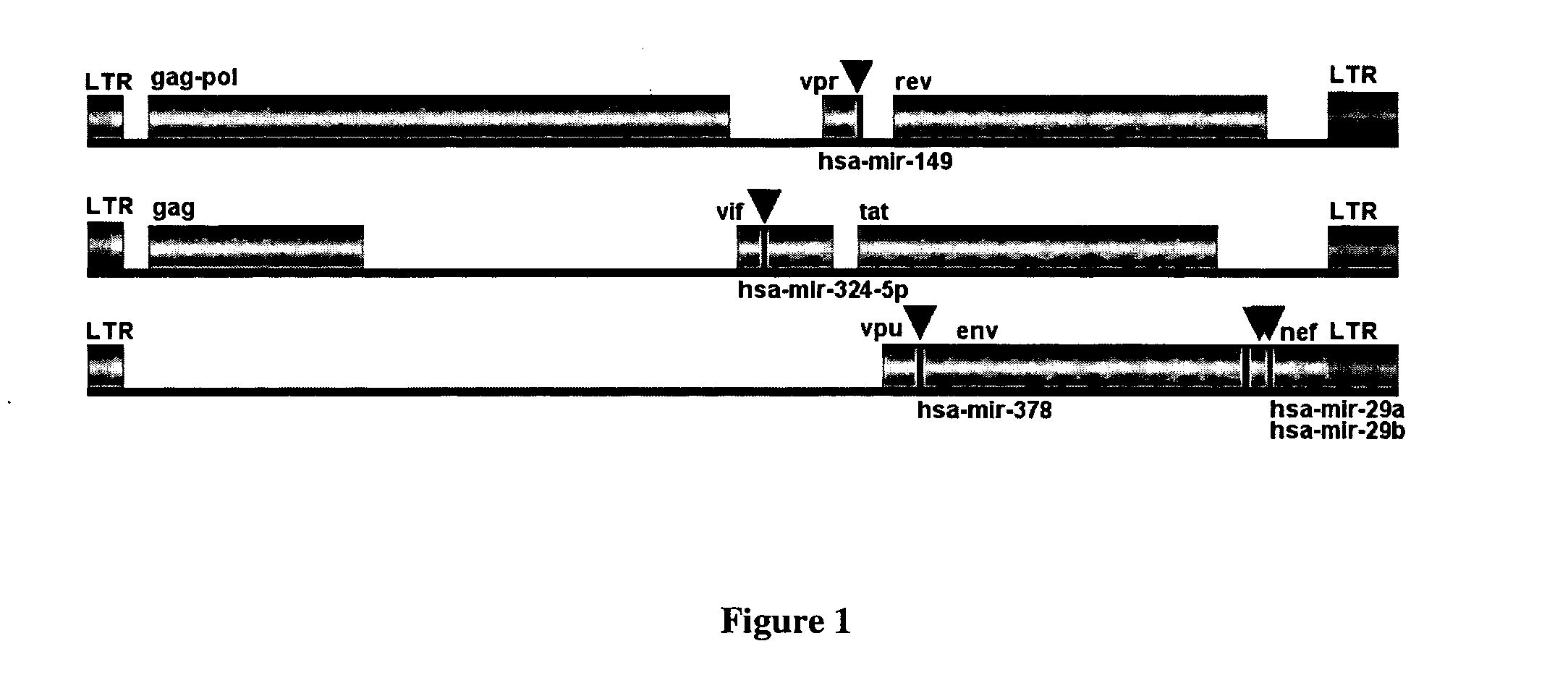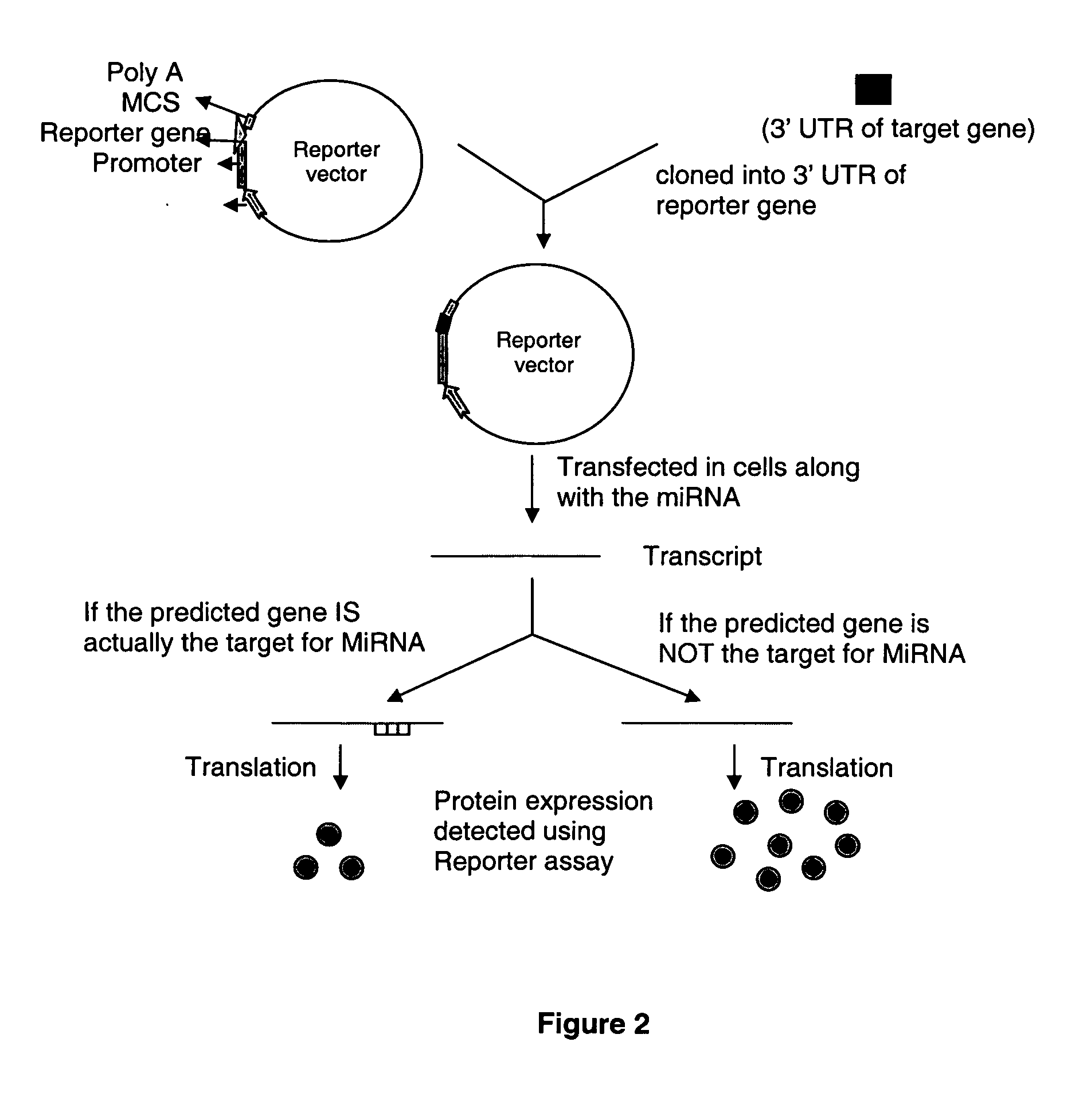Human microRNA targets in HIV genome and a method of identification thereof
a technology of human microrna and genome, applied in the field of human microrna targets in hiv genome, can solve the problems of reducing the immune system of the body, causing the patient to be susceptible to opportunistic infections and conditions like neoplasms, and the probability of failur
- Summary
- Abstract
- Description
- Claims
- Application Information
AI Technical Summary
Problems solved by technology
Method used
Image
Examples
example 1
[0064] The human microRNA mature sequences were downloaded from the database of miRNA maintained by the Sanger Center named—The miRNA Registry (microrna.sanger.ac.uk / sequences / ). The entire list of miRNA that were downloaded is given as Table 1. For querying probable targets in the HIV-1 genome, the inventors used the RefSeq validated HIV-1 reference sequence, obtained from http: / / ncbi.nlm.nih.gov and 12 representative related strain sequences, as identified by the International Committee on Taxonomy of Viruses (ICTV). The dade sequences were obtained from ICTV database [0065] (http: / / www.ncbi.nlm.nih.gov / ICTVdb / Ictv / fs_retro.htm). The accession numbers of the clades are given in Table 2.
example 2
Prediction of miRNA Targets in HIV-1
[0066] Four well-established microRNA target prediction softwares—miRanda, RNAhybrid, Microlnspector and DIANA-MicroT were used to predict targets for the 211 human miRNAs in the HIV-1 reference sequence and the 12 representative lade sequences. HIV-1 targets to human microRNAs were initially predicted using miRanda with default parameters (Gap Open Penalty:—8.0; Gap Extend: −2.0; Score Threshold: 50.0; Energy Threshold: −20.0 kcal / mol; Scaling Parameter: 2.0). In order to increase the stringency, a cut-off score was derived above which the miRNA-target pairs were selected. The cut-off score of 120 was derived by running the same program on a shuffled sequence of HIV-1 reference strain with the same set of miRNAs. HIV-1 genome sequence was shuffled using the EMBOSS2 program shuffleseq. This enabled filtering of probable false positive hits and selection of the most probable and high-scoring values. These short-listed HIV-1 targets to human microR...
example 4
Comparison of Target Sequences in Related HIV-1 Strains
[0070] The variability of viral genomes can pose a problem in using RNA interference. Therefore we compared the sequence conservation at the target site amongst different HIV-1 clades. It was observed that the target regions were significantly conserved. The genes to which the target regions belong varied among some of the strains, mostly in the Clade O. However, the clade O is known to be a highly polymorphic strain when compared to the other sub-groups M and N. The genes which encompass the target regions are tabulated in Table 4.
PUM
| Property | Measurement | Unit |
|---|---|---|
| pH | aaaaa | aaaaa |
| volume | aaaaa | aaaaa |
| volume | aaaaa | aaaaa |
Abstract
Description
Claims
Application Information
 Login to View More
Login to View More - R&D
- Intellectual Property
- Life Sciences
- Materials
- Tech Scout
- Unparalleled Data Quality
- Higher Quality Content
- 60% Fewer Hallucinations
Browse by: Latest US Patents, China's latest patents, Technical Efficacy Thesaurus, Application Domain, Technology Topic, Popular Technical Reports.
© 2025 PatSnap. All rights reserved.Legal|Privacy policy|Modern Slavery Act Transparency Statement|Sitemap|About US| Contact US: help@patsnap.com



